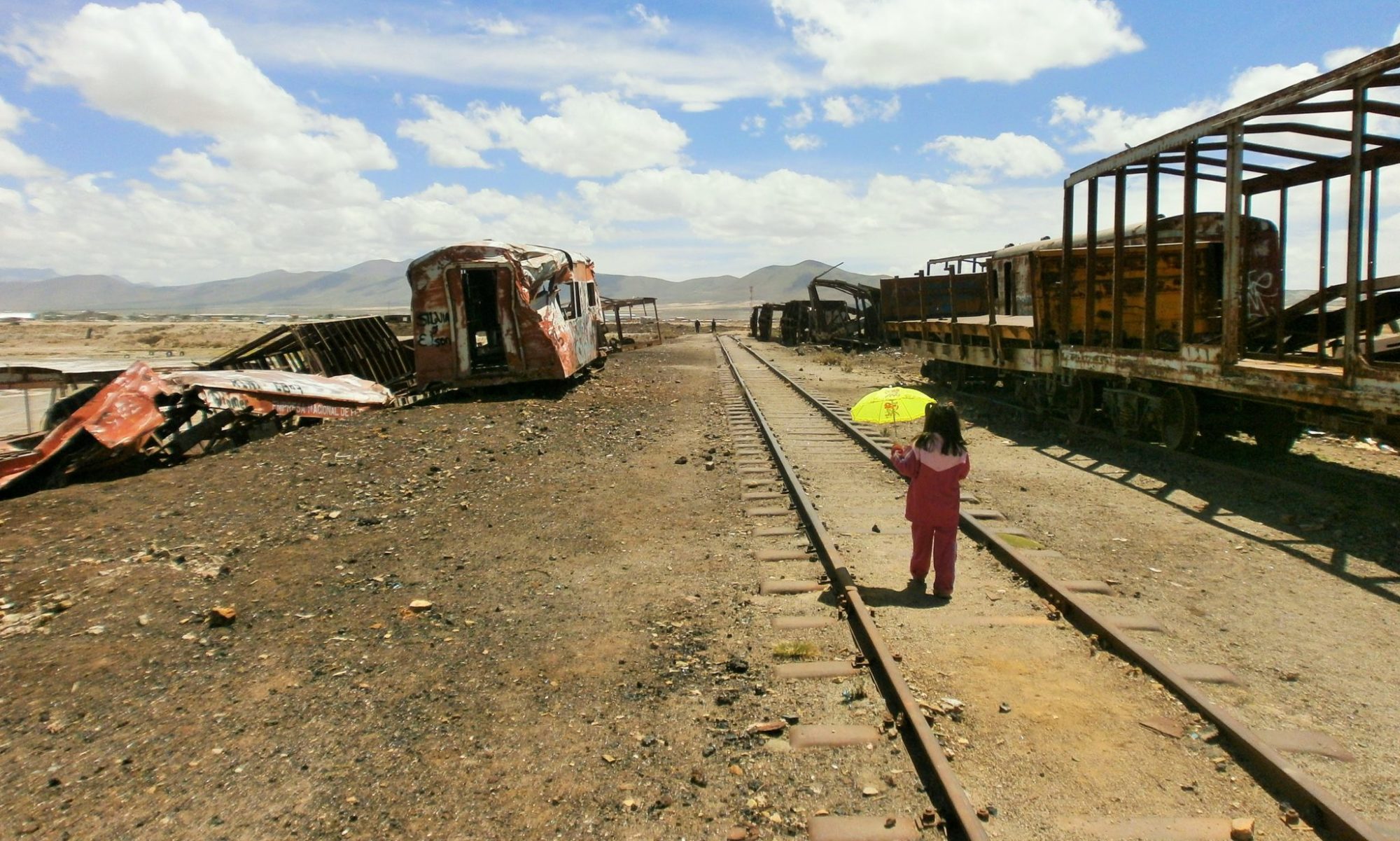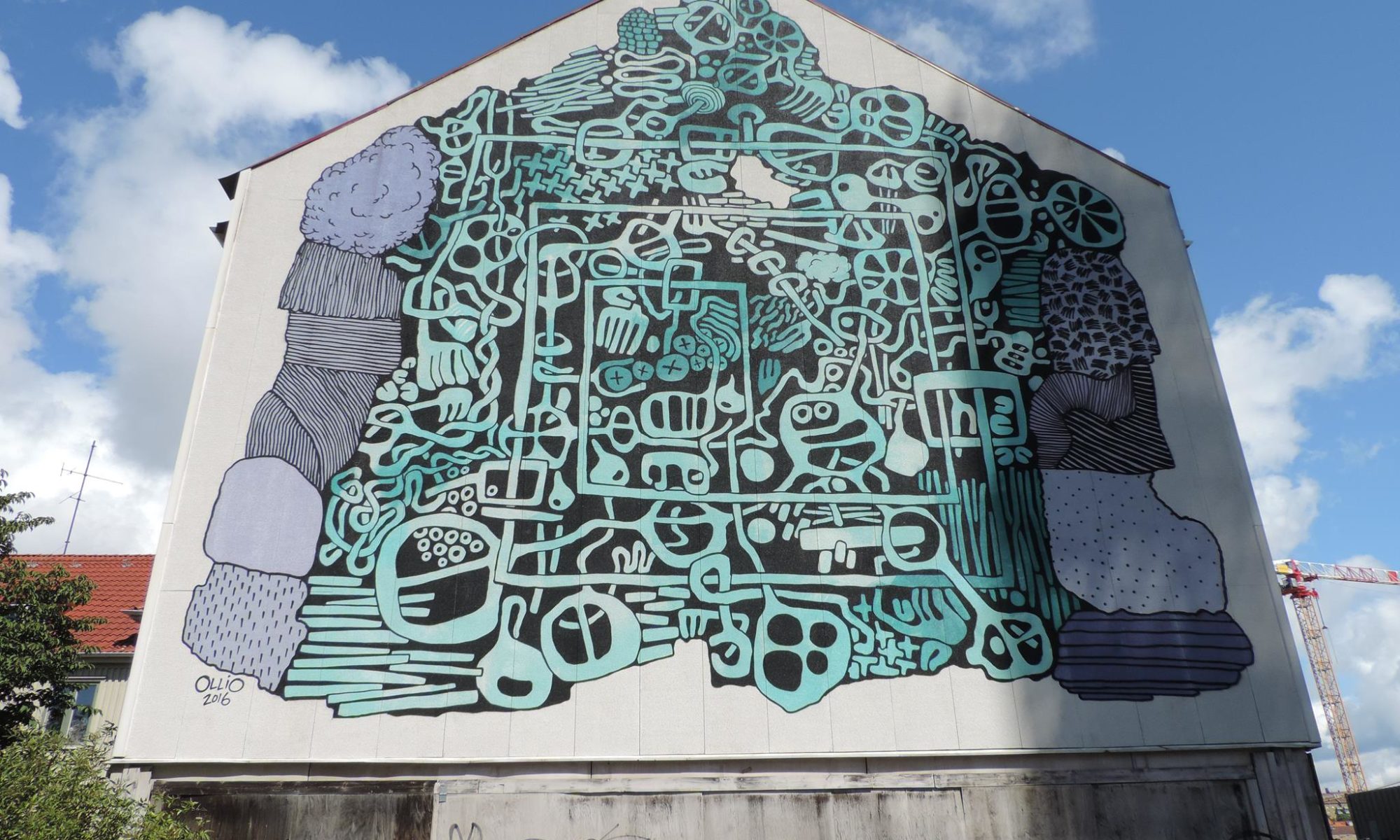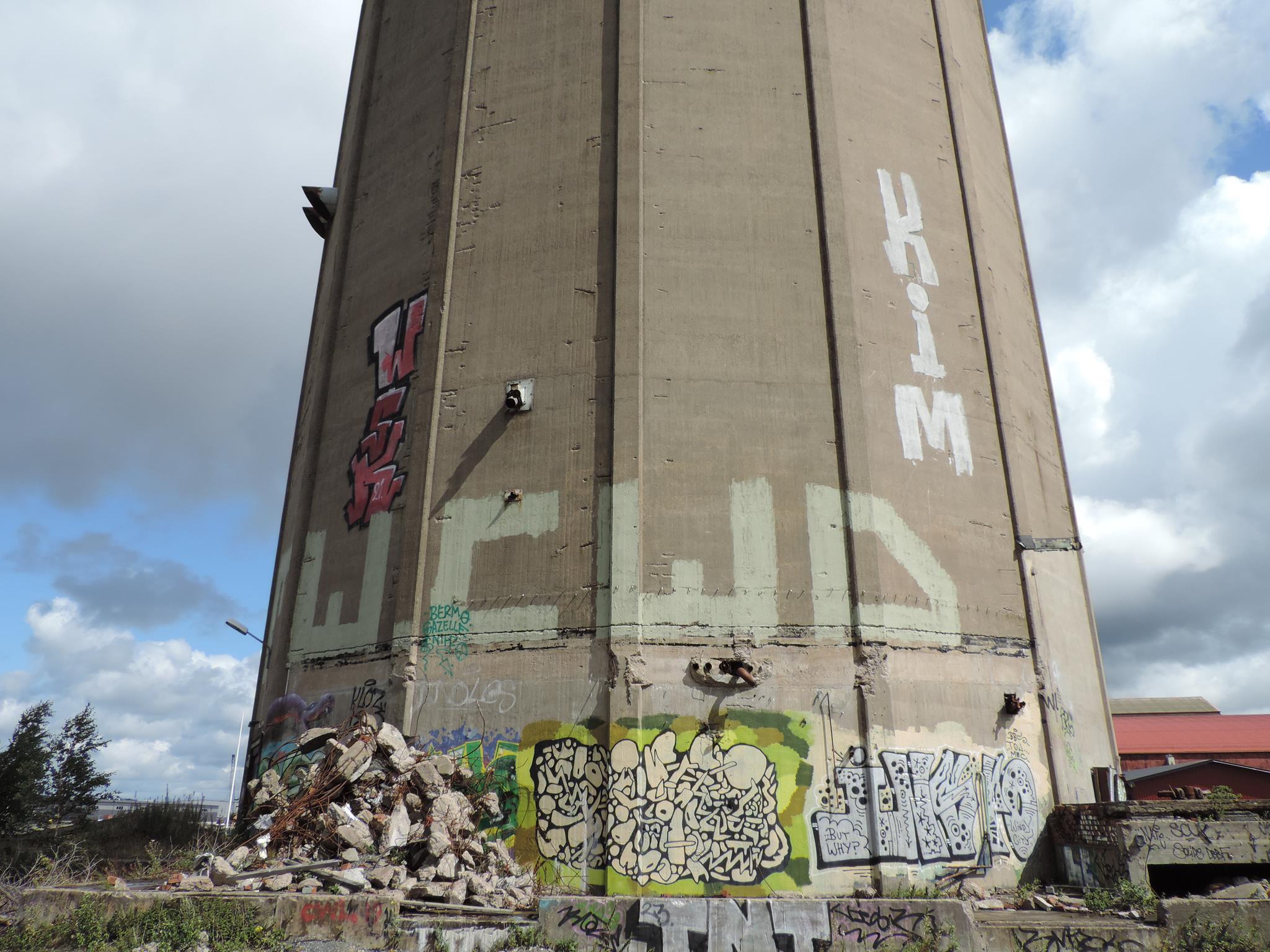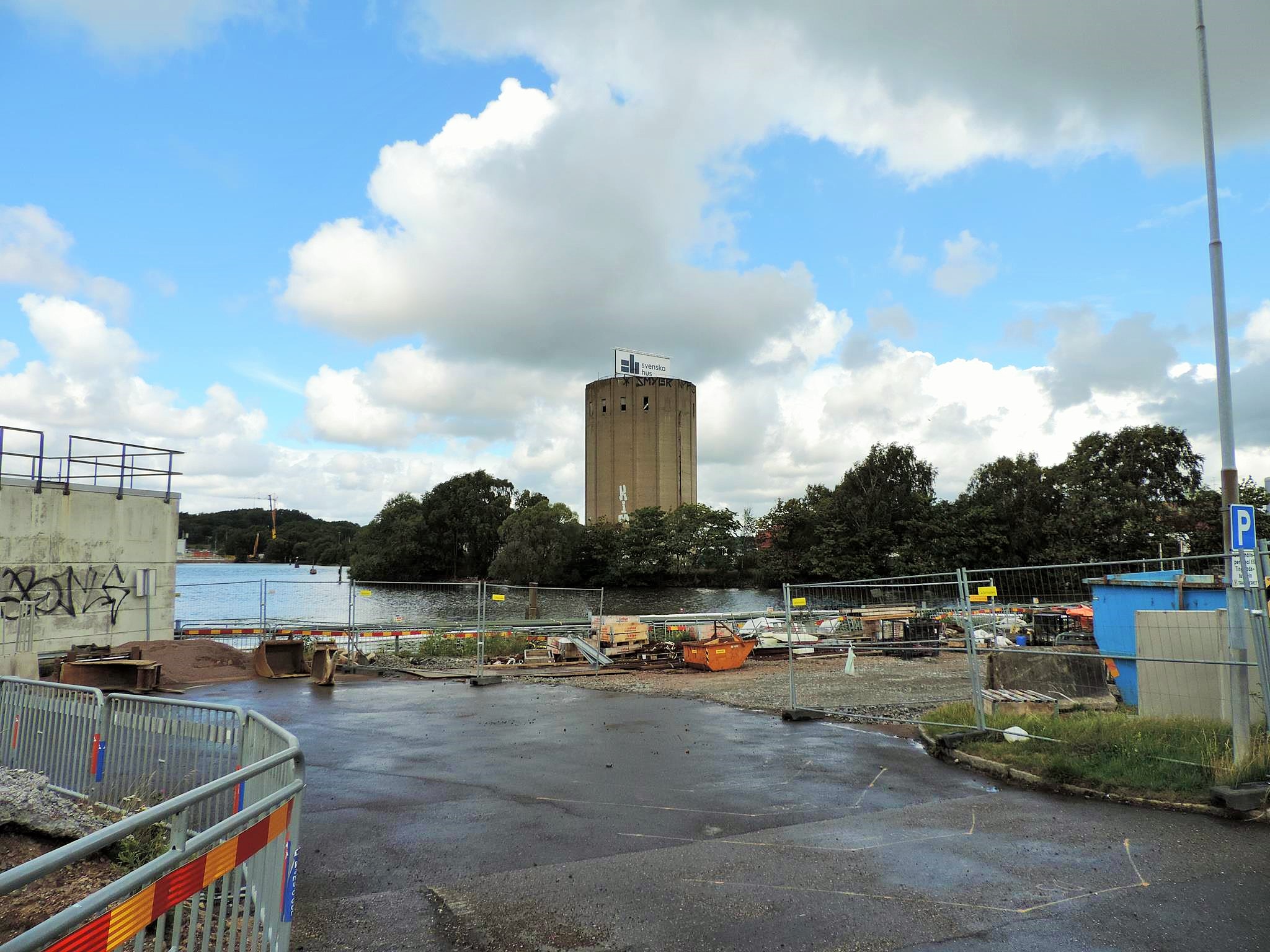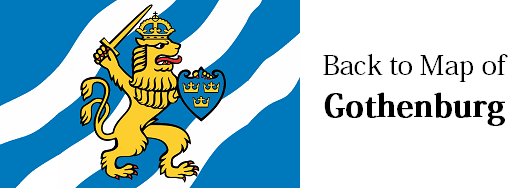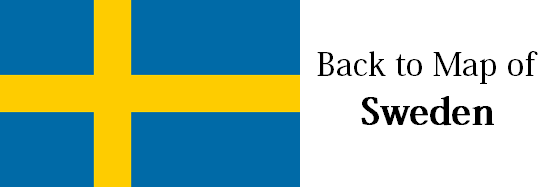The great creative JONATHAN JOSEFSSON aka OLLIO is probably one of the most important artists and cultural connectors for the Gothenburg urban art scene in recent years or even decades. Not only as an abstract painter and sprayer he creates astonishing formations that can embellish a small canvas as well as a whole block of houses. He also masters letter writing and runs the great ABSTRACT GRAFFITI MAGAZINE, or AGM for short, but much more important is his constant and active organizing, networking and linking of artists, venues and ideas.

Over the years, he brought numerous events and projects to life and laid the foundation for many more acquaintances among sprayers and the familial flourishing of the scene. He has taken care of graffiti locations that no longer exist, he is still doing it today for new locations and he is committed to open even more spaces where you can be freely creative on walls. Actually he did what he is doing as well with this interview series and the map for Gotheburg, without OLLIO everything of this documentation would not have happened, at least not in that way. He put the first puzzle pieces in motion, and then there followed great encounters and interviews with TONY B about his graffiti and his fantastic tattoo studio UNIKUM, with CABEL and the awesome GBG GRAFF MAGAZINE, also with CODE 26 about his abstract styles and as well with legendary DISK. Also the visit to the fantastic secret underground hall wouldn’t have happened without him making connections. Big Thanks to you OLLIO and Respect!

In an interview, he told us about his work and about some of his projects. This interview is a little different from the usual ones on the website, as it was a double interview. The conversation was conducted together with the fantastic artist CAMILA BOSTRÖM aka SCEB, she is his partner and both complement each other perfectly. In the audio you can listen to the full talk with both of them, below are the written parts concerning OLLIO with a variety of his works and if you want to know more about SCEB you can find these passages with photos on her individual interview page.
We started communicating several days ago. But you haven’t been in town because you just came back from Kosovo. From Pristina and from the Meeting of Styles. I saw some photos about the artworks you painted, but you also made the music and played some DJ sets.
Yes, exactly. From the beginning, I was invited as a graffiti artist, but I also told them that I also would love to play a set. It ended up playing the first set in the streets at the festival area, and then another set on a nightclub in central Pristina as well. So yeah, it was both music and painting there.

Around Gothenburg and at other places in the region I already photographed several murals from you. There is for example the huge mural from the Artscape festival in black and white, but as well I also have a lot of small ones. And just yesterday at Wargöns Bruk I found two wall paintings. I perceived those works as well like abstract. Several times it also reminded me of a puzzle. Like with a lot of puzzle pieces where the forms are getting into each other. But it’s not that the colors fade into each other. It’s like there are borders between the parts, but in some way they stick into each other and often you fill huge areas or sometimes also small areas with these patterns.
Yeah, that was a good summary. I have maybe a handful of different concepts that I work with and I try to change between them when and how I feel for it. But the most of them are based in a way like you described it. There are a lot of forms and they are mainly based on outlines. So it has like a concept of graffiti, but there are no letters anymore. There are just forms and patterns and repeatable objects that go into each other. But then sometimes I like to just do an artwork without outlines as well. Just with colors and I try that for some time and then I switch back. So it really depends on the mood in which I am and the mood for the moment. Also what I have available, which colors I have available as well.

Just today I have been to Hammarkullen and to Hjällbo . It’s not a ghetto, but you have these numerous huge grey buildings and I just imagined how it must be for a child to grow up in that area. All these tall multi apartment blocks next to each other and all in the same ugly color. It must be very depressing. But then artist like you came and put in some colors. There is a huge mural with a bird, also a child with a balloon and several more. So the Artscape crew organized the huge mural ones. But I saw that just on the back side you OLLIO added some more artworks by yourself. It’s also like a mission to give the people something in the neighborhoods and to make their surroundings more beautiful and nicer.
Yes, it is. That’s true. And I think that is a really nice feeling, if we accomplished that. But you never know. Some people love it, some people hate it. But I hope that it gives something to the society to make it a nicer place. But that is like my will and intuition. But you never know what comes out of it in the end, hopefully it has a good effect.

Especially the one I photographed this morning on the backside of a big and long building. There is this very long wall, and from bottom up till three meters it is just all black. I don’t know what can be worse than all total black. And why did they choose black of all possible colors?
Yeah, that is a really strange story with that building because before it was like a long grey wall. Really, really boring. Maybe with just some tags here and there, or some writing with “Fuck the Police” or something like that. And then they decided to make it like a graffiti wall. They invite the whole city to do graffiti there. And we also did a jam. We painted a very long wall, it was a really long one, like maybe 200 meters or even more. So it was after that weekend, it was filled with paintings. And it was also like an open wall. We could go there to paint, even after this graffiti. We went there a couple of times, so maybe I had three pieces there when they decided to shut it down and paint it all black. And then they painted everything black, but except my three pieces.

So there already was color on it and they wanted to over paint it, but they could have painted it red or green or whatever. Why did they use the darkest black? Very strange. So the three pieces are from the time before.
Yes, they are from the first graffiti wall. But it’s so strange and I don’t know why they left my works. Everything else they painted it all black. I don’t really know why they decided to do it, but they did it. But the really strange thing was that they decided to just keep my three paintings. But the really strange thing was that they decided to just keep my three pieces and they didn’t even give me an explanation why or how. There was also no money involved because it was a legal wall and they took it, but they kept this part, only this little part out of it. Really strange decisions were released.

From the perspective of urban art, I think during the last ten years Sweden is waking up again. Because for a long time you were somewhere in the Stone Age. Or in the dark Middle Ages. There was the zero tolerance agenda with politics. And when I compare it to Germany, we have bridges which are super legendary with graffiti artworks from the 90s. And nobody goes over it because this is just the piece from this and that famous artist. But here everything I photographed and found is from the last several years. So what did it mean, this „Zero Tolerance“?
If there was a tag, they immediately went over it and had a whole squad team. For a period there was really nothing at all. Now there is a lot more graffiti but it was never supported by the city. The city had like this policy that everything should be washed away in 24 hours, at least on the municipality buildings. You could never make an art workshop or a creative student group or anything like that. Nothing that is about graffiti or has a connection to graffiti was allowed. There were several different workshops going on before the zero tolerance, and they were all shut down. So no one should learn this at all. And there was like exhibitions going on. They were officially planned to take place, and they were just cancelled because of this. It was really strange. You couldn’t even have a classroom where kids could draw graffiti on a paper. That was not allowed to do that. Really strange. But I think they realized that it wasn’t the way to go only in full frontal attack on the graffiti culture. And now they instead really try to collaborate with the painters and do positive things instead. Then of course, there are some politicians who still don’t like it, but right now it’s looking kind of good, especially in Gothenburg.

Also you have now this „Planksidan“ or „Planket“ project with artworks on the construction walls, I have hundreds of photographs. And I realized when I will create a map for Gothenburg later on, I need a completely new category because no other city has something like this in that amount. But it is very nice to see, so from „Zero Tolerance“ now there is the opposite approach. You’re developing in a new stage and there are also new ideas which other cities don’t even have yet. But actually it’s an easy concept and there is always in every place around the world somewhere a construction fence you could use. Also it’s something which is just temporary and not permanent. So I was wondering, and thought for this map I would need a complete new category. Maybe a name like “Temporary Diamonds” or something like that.
Yes, and I think it’s a super cool idea because everybody does have a benefit from it. The people who are passing, the artists and also the construction site. I like the idea when we first heard about it, but we were suspicious and we thought, well, they’re not going to pay us any good. It’s going to be shitty anyway. But this has been proven to be the other way. They actually pay the artists well. So I think it’s a solid project that is financed and done very well. And this walls, they are not just on a small construction site which will be there for a month. I mean there are like huge construction areas where they build like a skyscraper or something. So there are walls which will be there for three years or longer. I think the usual period for length is about one year for the walls. But then the Danish guys from INSTITUT FOR URBAN KUNST have been here and they have been doing some really huge long walls which are around 100 or 150 meters each. And I think they’re going to keep those a little bit longer, maybe two or three years. You should definitely put up the link for the application so everyone can apply and it is also possible to apply several times too.

I think this is a really good concept and a good opportunity for the artists as well. I’ve seen two amazing ones by SHAI DAHAN from New York. The one wall he made about 400 years of Gothenburg. There is a whole history in following paintings about 400 years of city history. I think he made actually two walls and the other one is next to the Liseberg Park with famous people from Sweden. It’s really interesting how he put the parts together. It’s a cool way to present the city and the country. I have also seen the other huge wall about 1000 years of Gothenburg with knights and important happenings, but I think that one was not from him.
No, that one is not from SHAI DAHAN, that was the one from the Danish guys. There was a Danish collective of painters in town called the INSTITUT FOR URBAN KUNST. They made it in July 2023. But SHAI DAHAN has also made another artwork at the Gothenburg airport inside a terminal in Landvetter.

How and when did you start painting and doing graffiti and streetart?
I have the classic graffiti background. I started in the 90s at my school. All the boys were tagging and I was inspired by them. I got a couple of graffiti magazines from a friend and really wanted to learn to do these huge colorful walls. So just started and I did my first wall in 1996. Then for a couple of years I really painted like classic graffiti and tried to do all the wild style. I was very inspired by German writers and the Copenhagen writers like BATES and those guys. So first it was really the lettering. Yes, it was mainly about the letters. But then I started to do an art school in 1999 and that gave me a lot of other influences. I started to experiment with the forms itself, because I got a little bit tired of doing only letters. So I started doing more abstract stuff and playing with the forms and patterns. And during the years it has evolved into something that is not classic graffiti at all anymore. Still it has that base. But nowadays I very seldom do letters anymore. I only do like patterns and abstract pieces, sometimes also figurative stuff, but not that much.

I think it’s as well a bit similar to music. When people say, this is hip hop or this is punk or whatever, I think these descriptions are helpful to describe somebody else what it is. But the words are only pure in theory, but in reality there is nothing to 100% like the description. You always have a mix. With graffiti, you can say, okay, these are the letters. That’s graffiti. But then there are some letters and there is also a character. So what is this? Is now not graffiti anymore or what is it? And then you have maybe a lot of characters and just a little lettering. So is this now streetart or is it character art or is graffiti.
Yes, that’s true. I think it’s a good similarity. I like that it’s showing us different genres and graffiti is like a genre of art. And then in graffiti there’s a lot of subgenres, like abstract graffiti, anti-style, wildstyle and characters and all that. So yeah, you could compare it to punk, hard rock, death metal, black metal and so on.

And how is it with somebody who makes a really proper lettering graffiti, but maybe this time with a brush? Is this a not a graffiti writer because there are no cans involved? I think you can use these words for some description, but in real life it’s not that strict. It all flows into each other. I think BANKSY said this once, that you have graffiti with the letters and everything else is streetart. Just to make a bit of definition. But then it would also mean that the character works are streetart and you have the problem that the graffiti writers say, no way, that’s graffiti. So a lot of styles and namings are still developing. Meanwhile often a new word is used which gets it maybe better, so it’s all “urban art”, which just means all kind of creative stuff in urban space.
That’s a good word. But I also think that in the end, it doesn’t really matter. I don’t need like a name on it, but as long as I like it, then it’s good. I have a project where I have started to make a magazine that is only dedicated to one of those subgenres that I was talking about, and that is the ABSTRACT GRAFFITI MAGAZINE or in short just AGM. It’s also linked on my Instagram channel. I started to make this magazine during the pandemic where I had a lot of time over and I didn’t know what to do. I already had this idea for a couple of years, so then I had time and I decided to make the first number. I think it was very warm welcome and a feeling that it was something people really liked. So I’ve continued doing it, and the last edition was number six. Soon I’m going to start working with number seven as well.


Really cool! We live now in the digital age, but still some people like to have print magazines or books. And if somebody does a non commercial print magazine in these days, it means there is really a lot of passion behind.
Yes, and I really like to feel it when I have it in my hands. It’s really nice to have it and also to keep it in your bookshelf because you see a lot of good stuff on Instagram on your phone, but actually nothing stays with you. You almost forget it just a minute after you put the phone away. To print it in a magazine and sell it to people that can keep it like forever, or at least like 50 years from now. I think it has a real value. And it was really funny because one of the guys who helps me with the magazine, his name is ANERS REVENTLOV and he is from Malmö. He said, maybe one day a teenager will pick this magazine up and it will be for him, as it was for me when I saw Subway Art for the first time. But this is like a complete different style, and it would be cool if it had that same impact as Subway Art had on the kids back then in 1985.

Yes, it’s definitely a huge difference. And it’s more special than just millions and millions of photographs you have every day on Instagram. So about the concept, that means people can send you photos or how does it work?
Basically yes. The photos are not all from other people, of course I also put some of my own photos on, but I don’t have that much. And I mostly have photos just from Gothenburg. So I make like an open call mostly on Instagram, and people send me their stuff. It’s easy like that. But when I made the last edition, which was number six, I got so many good photos, so it was really hard to choose which one should be in the magazine. So yeah, which is also nice and positive to get so much interesting material and feedback.

So people can send their stuff to you, very cool. Another topic I also want to talk with you about, because you’re an artist and you make this magazine, but as well you organize art events or collaboration projects. Some days ago I wanted to go to this famous art flea market, but this area was demolished and they’re building something new. I read some info about it and also somebody told me that this area was actually organized by you once. Is this true?
Not really, I was just involved during a period of maybe ten years. During that time I had like a deal with the guy who run the flea market. I painted his signs on the roof and then he let me paint whatever I wanted on the walls around the buildings. But other than that, I had nothing to say or decide who could paint there or not. But a lot of people thought that I was the boss. But I wasn’t. I was just like doing a lot of stuff there and no one else asked the owner to if they could paint there. So during those years, a piece could stay maybe two or three years. But the last two years it was more like an open graffiti wall or even Hall of Fame where people painted every day. So the pieces didn’t stay long at all, but it was still nice as well. Other people could just have asked the owner, but mostly they didn’t. They asked me instead. Sometimes the people asked me and I only said that they can ask the owner or they can go there with me. We can paint together. So that was like the deal.
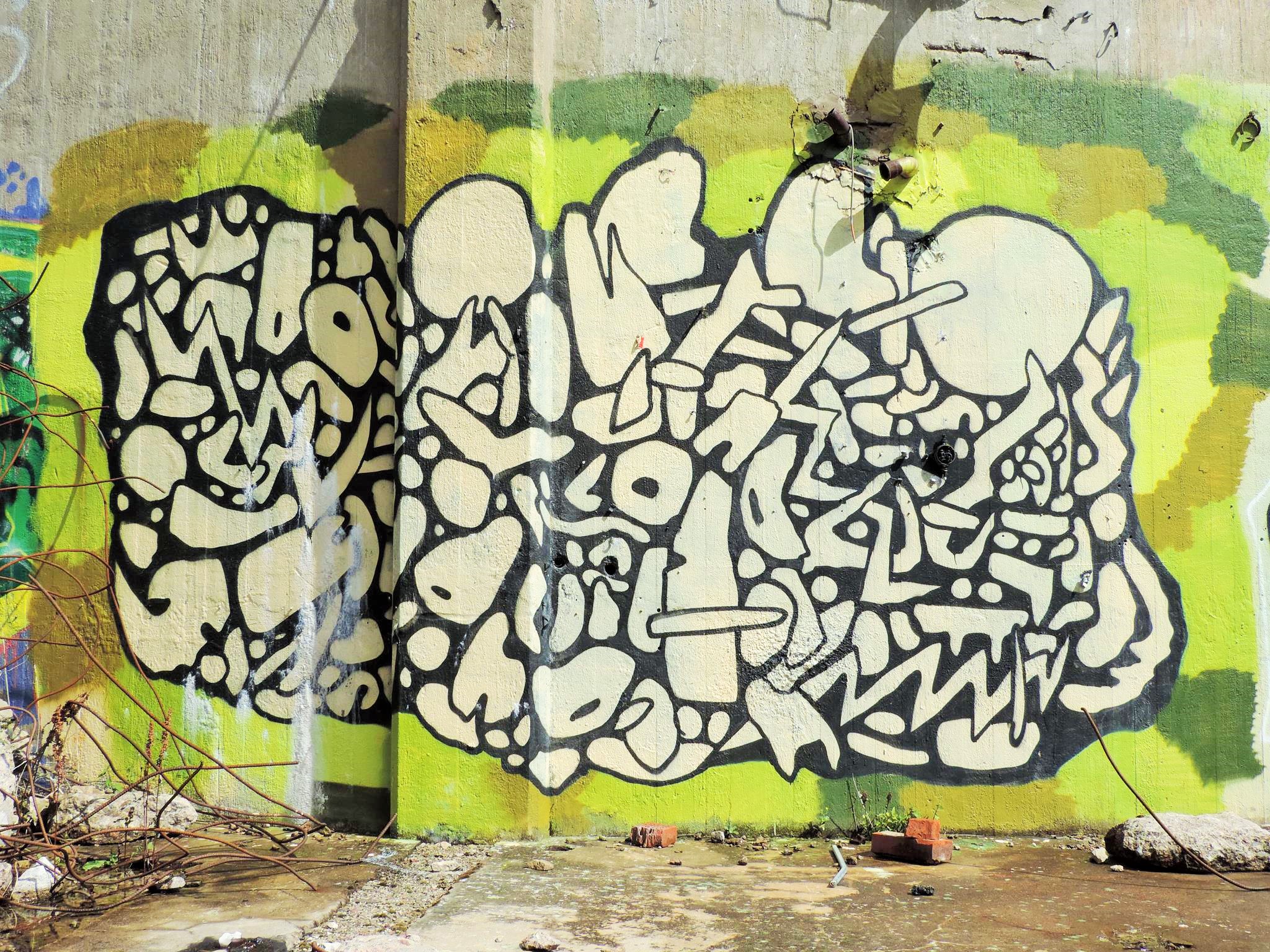
You also like to go to festivals like the Pompeii Street Festival and you also have been to a jam several weeks ago in Germany. Actually we’ve been at the same event. But there we didn’t know each other yet. So you came also to Germany to the Meeting of Styles in Wiesbaden.
Yeah. Yes, it was really nice! It was actually the first time to the Meeting of Styles for me. I’ve been to several others festivals, both street art and graffiti, but never been to a Meeting of Styles yet and never been to Wiesbaden either. But it was super nice! I liked it!

Yes, there are hundreds of artists and it’s really huge. You have the whole city with some parts and also several walls of which you could say that each wall is an own jam itself.
Yeah, definitely! I was impressed by the organization in Wiesbaden and they seem to be veterans at doing this. Because I think they’ve done it a lot of that. They’re doing these events since around 20 years meanwhile or something. So they really know what they were doing. That was good.

What did you paint there?
We did a big collaboration wall in a new part on the left side of the tunnel where they were building a skate park. And then my part was on a climbing wall, which was kind of fun. Because I had to paint over the climbing things and those elements. Those elements gave the piece a little bit of 3D feeling. I had to paint in a 3D style. And I tried to do the same stuff as you do the wall. So yeah, it was fun and it came out good. That was really interesting.

So especially about this painting, the people can not only look at it, they can also climb on it.
Yes, exactly. Which is really fun. And as soon as I was finished there, like five minutes after, a lot children ran up to it and started to climb on it. So it was really nice, a good photograph with a lot of people climbing and it looked good. But I don’t know for how long it will hold. Maybe if people climb there every day, it will be warmed and turned a little bit. So we have to see next year how it looks.

Several days ago I was at the Röda Sten Konsthall at the river where the big bridges stand. It’s a great place and there is also a legal graffiti wall. But at the moment, because it’s like summer holidays, there have been a lot of kids workshops and I’ve seen a lot of artworks from children. So at that day there were not really high quality artworks on the walls to discover. But there was something else which was very interesting. There was one part of the wall and actually all the paint layers came off. I think that must have been maybe 40 layers. It just went off the wall and then there was again a graffiti behind. So the 41st layer. So this was again interesting to see.
Yes, that wall actually und that whole size, it’s really a lot of paint over and over and over. Layers of layers of layers.

At that time when I visited, they were doing these workshops. But for the listeners or readers, if you come to Gothenberg, you should definitely visit that place. It’s a legal spray wall. At the same time you can also visit the “Konst Hall” next to it. It means “Art Hall” in English and it is quite interesting. They have nice exhibitions. And what other places would you recommend for people who love urban art?
Right now we have a legal wall in the center of Gothenburg, which is reall interesting. It is close to Yankton and it’s called Maastricht Vägan, a new one. We have also maybe four more legal walls, not in the center area, but in the outskirts of the city. Bergsjön is one of them.

On this line it is the last stop of the metro trains, so the final station.
Yes, with the tram. And then on another tram line there is at the last stop Maastricht Vägan. And then we have around two or three more legal walls. They are 20 minutes by bus outside of Gothenburg, in the other municipalities around. Which is better to have more space, so yeah, we have some cool places as well. Also Planksidan, ArtMadeThis and Artscape. They have done a lot of walls around Gothenburg as well during maybe three different years or something. And they did several festivals.

The project by ArtMadeThis is quite interesting. It’s in a parking house. And first I didn’t expect to have so many artworks inside because there is just a little sign on the entrance. But there is actually really a lot more and till the fifth floor you get heaps of artworks. On every floor there are around six or more pieces. So altogether you have around 30 or even more. It’s kind of an own exhibition. And Artscape, they did definitely a great job. They are responsible for a lot of the murals around the city.
Yes, and they made a brand new one on the other side of the river, which is really huge. I have only seen it on pictures, but it’s a really big one.

You mentioned before that you do as well other kind of arts, especially you create rugs.
Exactly. So I work with a lot of different materials. I like to experiment and try new stuff. And especially in the winter time, I am in my studio painting canvases and do different stuff. But one of my main materials are rugs, textile rugs that I do with a tough thing machine, which is kind of funny because this machine is like a gun, almost like a gun that shoots in the yarn into a fabric. And it really reminds me of working with a spray can. You have like a trigger that you have to push to make it work. And then you also have to have the same focus as I do when I spray with the spray can. So there are similarities. That is kind of fun. And then in the end they look really different, of course. But there are also like some similarities in the artwork, in the form and in the colors. So I show these rugs on my exhibitions, which I also do maybe 3 or 4 exhibitions a year, mostly around Sweden. So I work with different galleries and I do exhibitions during the years.

So OLLIO and SCEB, it was a very interesting and great talking to you. Thank you very much for this cool interview!
Thank you too! It was really nice. And if you listeners and readers, if you come to Gothenburg at any time, you can always give us a message on Instagram or whatever and we can guide you and help you out.

![]()
ARTWORKS BY OLLIO ON THE GOTHENBURG MAP
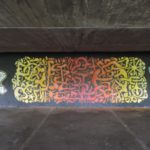
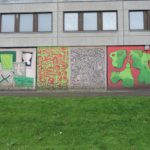
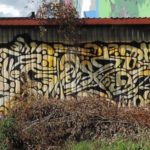
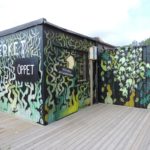
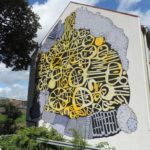
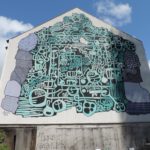
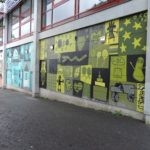
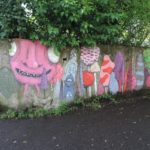
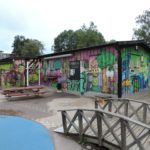
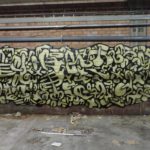
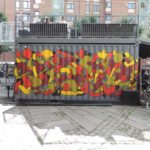
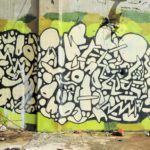
![]()
ARTWORKS BY OLLIO IN SWEDEN


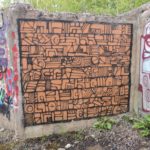
![]()
INFOTHEK
![]() Artist: OLLIO
Artist: OLLIO
![]() Facebook: https://www.facebook.com/profile.php?id=100066497336322
Facebook: https://www.facebook.com/profile.php?id=100066497336322
![]() Instagram: https://www.instagram.com/ollio
Instagram: https://www.instagram.com/ollio
![]() Tumblr: https://ollio.tumblr.com
Tumblr: https://ollio.tumblr.com
![]() Etsy: https://www.etsy.com/shop/scebandollio
Etsy: https://www.etsy.com/shop/scebandollio
![]() Podcast: https://hearthis.at/radio-x-interviews/sceb-ollio
Podcast: https://hearthis.at/radio-x-interviews/sceb-ollio
![]() Interview: https://vagabundler.com/sprayer/ollio
Interview: https://vagabundler.com/sprayer/ollio
![]()
![]() Graffiti Magazine: ABSTRACT GRAFFITI MAGAZINE
Graffiti Magazine: ABSTRACT GRAFFITI MAGAZINE
![]() Instagram: https://www.instagram.com/abstractgraffitimagazine
Instagram: https://www.instagram.com/abstractgraffitimagazine
![]()
![]() Photographer: OLLIO & VAGABUNDLER
Photographer: OLLIO & VAGABUNDLER
![]()
![]() Construction Wall Project: PLANKSIDAN – PLANKET
Construction Wall Project: PLANKSIDAN – PLANKET
![]() Website: https://www.trafikverket.se/vara-projekt/projekt-i-vastra-gotalands-lan/vastlanken/planksidan
Website: https://www.trafikverket.se/vara-projekt/projekt-i-vastra-gotalands-lan/vastlanken/planksidan
![]()
![]()
RECOMMENDABLE GRAFFITI SPOTS IN GOTHENBURG
>>> Underground Hall of Fame <<<
>>> Bergsjön Graffiti Hall <<<
>>> Artscape Festivals <<<
>>> Röda Sten Spray Space <<<
>>> Vulkano Art Space <<<
>>> Emigrantvägen Graffiti Wall <<<
>>> Landvetter Graffiti Wall <<<
>>> Gothenburg History Mural <<<
![]()
![]()
MORE ARTICLES ABOUT SWEDEN
>>> Streetart Map Stockholm <<<
>>> Streetart Map Gothenburg <<<
>>> Streetart Map Borås <<<
>>> Kulturkvarter Snösätra <<<
>>> Streetart Södertälje <<<
>>> Artscape Festivals <<<
>>> #ArtMadeThis <<<
>>> OLLIO – Urban Artist <<<
>>> SCEB – Urban Artist <<<
>>> TONY B – Tattoo & Graffiti <<<
>>> CABEL – Graffiti Artist <<<
>>> CODE 26 – Graffiti Artist <<<
>>> DISK – Graffiti Artist <<<
>>> FILIP REM – Abstract Painter <<<
>>> Movement Biskopsgården <<<
>>> Lost Place Graffiti – Wargöns Bruk <<<
>>> Urban Art – Hammarkullen <<<
>>> Urban Art – Hjällbo <<<
>>> Urban Art – Kungälv <<<
>>> Urban Art – Nödinge <<<
>>> Urban Art – Trollhättan <<<
>>> Urban Art – Vänersborg <<<
>>> Urban Art – Landvetter <<<
>>> Urban Art – Tumba <<<
